消息队列—ActiveMQ
1. 学习计划
1、什么是MQ
2、MQ的应用场景
3、ActiveMQ的使用方法。
4、使用消息队列实现商品同步。
2. 同步索引库分析
方案一:在manager(后台)中,添加商品的业务逻辑中,添加一个同步索引库的业务逻辑。
缺点:这样违背了服务单一职能的原则,业务逻辑耦合度高,业务拆分不明确。
方案二:业务逻辑在search中实现,调用服务在manager实现。业务逻辑分开。
缺点:服务之间的耦合度变高,search服务依赖manager服务,服务的启动有先后顺序。
方案三:使用消息队列。MQ是一个消息中间件。

MQ是一个消息中间件,ActiveMQ、RabbitMQ、kafka(大数据)。
系统服务之间,非直接通信,而是通过MQ进行转发,这样既解决了系统之间的通信问题,同时也避免了系统之间的依赖和耦合。
消息队列的主要应用:
解决系统之间的通信问题
降低系统之间的耦合度
互联网项目中,为了用户的体验,必须遵守快速响应用户的原则,比如在电商项目中,当用户下单之后,其实还有很多的后续业务需要完成,用户根本不可能等你的流程全部处理完才得到下单反馈。这是后我们可以利用消息队列,在既能够快速响应用户的同时,有能后将业务消息压入MQ中,通过MQ的流转,通知后续业务的开展,达到数据最终一致。
3. ActiveMQ
3.1. 什么是ActiveMQ
ActiveMQ 是Apache出品,最流行的,能力强劲的开源消息总线。ActiveMQ 是一个完全支持JMS1.1和J2EE 1.4规范的 JMS Provider实现,尽管JMS规范出台已经是很久的事情了,但是JMS在当今的J2EE应用中间仍然扮演着特殊的地位。
主要特点:
1. 多种语言和协议编写客户端。语言: Java, C, C++, C#, Ruby, Perl, Python, PHP。应用协议: OpenWire,Stomp REST,WS Notification,XMPP,AMQP
2. 完全支持JMS1.1和J2EE 1.4规范 (持久化,XA消息,事务)
3. 对Spring的支持,ActiveMQ可以很容易内嵌到使用Spring的系统里面去,而且也支持Spring2.0的特性
4. 通过了常见J2EE服务器(如 Geronimo,JBoss 4, GlassFish,WebLogic)的测试,其中通过JCA 1.5 resource adaptors的配置,可以让ActiveMQ可以自动的部署到任何兼容J2EE 1.4 商业服务器上
5. 支持多种传送协议:in-VM,TCP,SSL,NIO,UDP,JGroups,JXTA
6. 支持通过JDBC和journal提供高速的消息持久化
7. 从设计上保证了高性能的集群,客户端-服务器,点对点
8. 支持Ajax
9. 支持与Axis的整合
10. 可以很容易得调用内嵌JMS provider,进行测试
3.2. ActiveMQ的消息形式
对于消息的传递有两种类型:
一种是点对点的,即一个生产者和一个消费者一一对应;(只能有一个消费者)
另一种是发布/订阅模式,即一个生产者产生消息并进行发送后,可以由多个消费者进行接收。(广播)
JMS定义了五种不同的消息正文格式,以及调用的消息类型,允许你发送并接收以一些不同形式的数据,提供现有消息格式的一些级别的兼容性。
· StreamMessage -- Java原始值的数据流
· MapMessage--一套名称-值对
· TextMessage--一个字符串对象
· ObjectMessage--一个序列化的 Java对象
· BytesMessage--一个字节的数据流
4. ActiveMQ的安装
进入http://activemq.apache.org/下载ActiveMQ
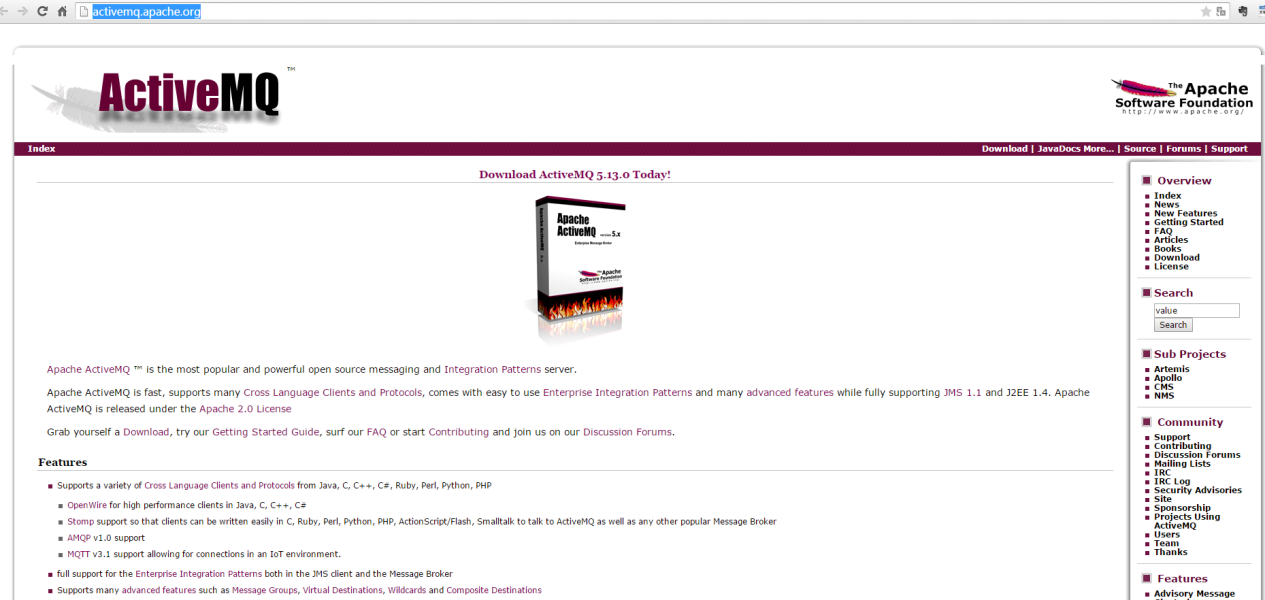
使用的版本是5.12.0
4.1. 安装环境:
1、需要jdk
2、安装Linux系统。生产环境都是Linux系统。
4.2. 安装步骤
第一步: 把ActiveMQ 的压缩包上传到Linux系统。
第二步:解压缩。
第三步:启动。
4.3.启动,查看,关闭
使用bin目录下的activemq命令启动:
[root@localhost bin]# ./activemq start
关闭:
[root@localhost bin]# ./activemq stop
查看状态:
[root@localhost bin]# ./activemq status
4.4 细节
注意:如果ActiveMQ整合spring使用不要使用activemq-all-5.12.0.jar包。建议使用5.11.2
进入管理后台:
http://192.168.25.168:8161/admin
用户名:admin
密码:admin
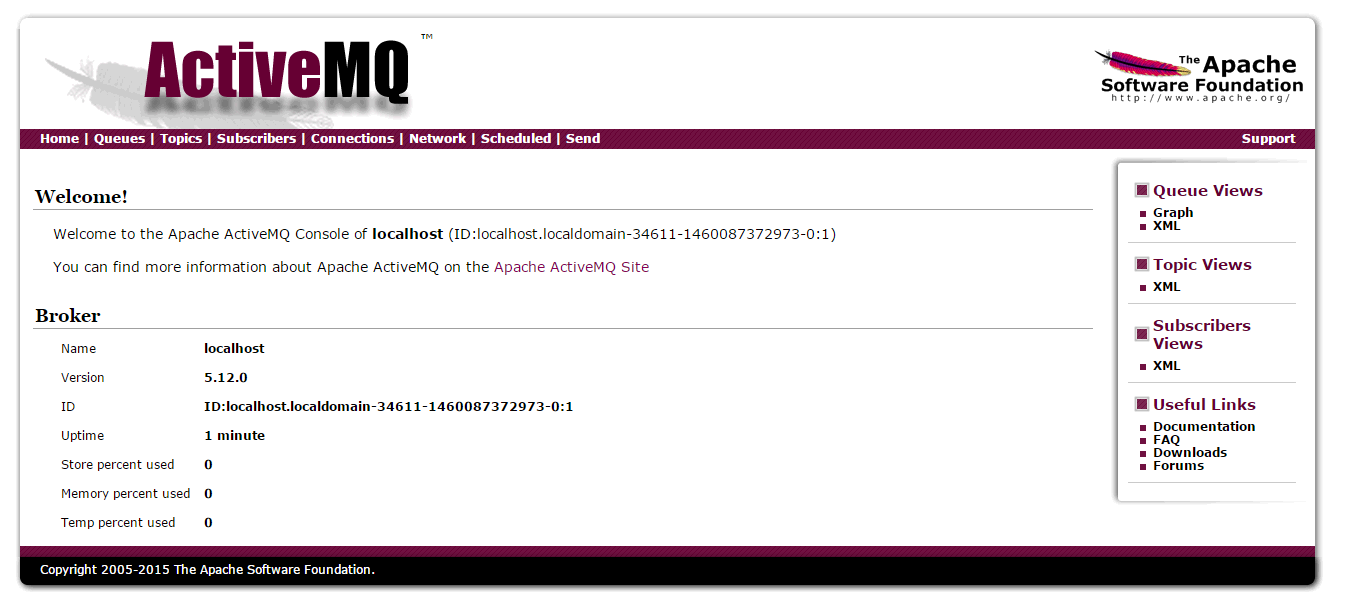
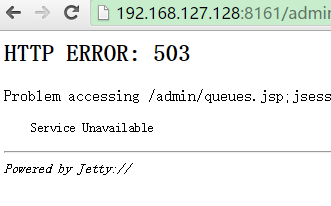
503错误解决:
1、查看机器名
[root@arjenlee168 bin]# cat /etc/sysconfig/network
NETWORKING=yes
HOSTNAME=arjenlee168
2、修改host文件
[root@arjenlee168 bin]# cat /etc/hosts
127.0.0.1 localhost localhost.localdomain localhost4 localhost4.localdomain4 arjenlee168
::1 localhost localhost.localdomain localhost6 localhost6.localdomain6
[root@arjenlee168 bin]#
3、重启Activemq服务
5. ActiveMQ的使用方法
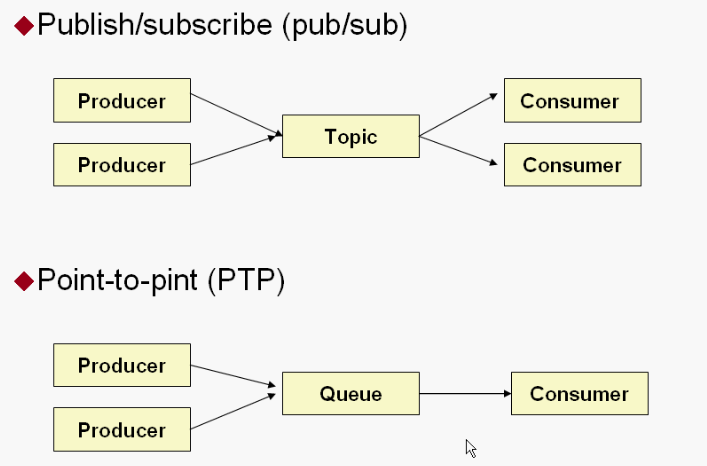
下面是java代码依据JMS规范操作MQ。
5.1. Queue
- Queue消息形式,服务端默认进行持久化。
- Queue消息形式,只要被任意一个consumer消费后,服务端消除该消息,即一个消息只能被一个consumer消费。
如果消息没有被消费,则会一直被保存在服务端,直到被消费为止。
5.1.1. Producer
生产者:生产消息,发送端。
把jar包添加到工程中。使用5.11.2版本的jar包。

5.1.1.1 创建步骤
第一步:创建ConnectionFactory对象,需要指定服务端ip及端口号。
第二步:使用ConnectionFactory对象创建一个Connection对象。
第三步:开启连接,调用Connection对象的start方法。
第四步:使用Connection对象创建一个Session对象。
第五步:使用Session对象创建一个Destination对象(topic、queue),此处创建一个Queue对象。
第六步:使用Session对象创建一个Producer对象。
第七步:创建一个Message对象,创建一个TextMessage对象。
第八步:使用Producer对象发送消息。
第九步:关闭资源。
5.1.1.2 代码示例
@Test
public void testQueueProducer() throws Exception {
// 第一步:创建ConnectionFactory对象,需要指定服务端ip及端口号。
//brokerURL服务器的ip及端口号
ConnectionFactory connectionFactory = new ActiveMQConnectionFactory("tcp://192.168.25.168:61616");
// 第二步:使用ConnectionFactory对象创建一个Connection对象。
Connection connection = connectionFactory.createConnection();
// 第三步:开启连接,调用Connection对象的start方法。
connection.start();
// 第四步:使用Connection对象创建一个Session对象。
//第一个参数:是否开启事务。true:开启事务,第二个参数忽略。
//第二个参数:当第一个参数为false时,才有意义。消息的应答模式。1、自动应答2、手动应答。一般是自动应答。
Session session = connection.createSession(false, Session.AUTO_ACKNOWLEDGE);
// 第五步:使用Session对象创建一个Destination对象(topic、queue),此处创建一个Queue对象。
//参数:队列的名称。
Queue queue = session.createQueue("test-queue");
// 第六步:使用Session对象创建一个Producer对象。
MessageProducer producer = session.createProducer(queue);
// 第七步:创建一个Message对象,创建一个TextMessage对象。
/*TextMessage message = new ActiveMQTextMessage();
message.setText("hello activeMq,this is my first test.");*/
TextMessage textMessage = session.createTextMessage("hello activeMq,this is my first test.");
// 第八步:使用Producer对象发送消息。
producer.send(textMessage);
// 第九步:关闭资源。
producer.close();
session.close();
connection.close();
}
5.1.2. Consumer
消费者:接收消息。
5.1.2.1 创建步骤
第一步:创建一个ConnectionFactory对象。
第二步:从ConnectionFactory对象中获得一个Connection对象。
第三步:开启连接。调用Connection对象的start方法。
第四步:使用Connection对象创建一个Session对象。
第五步:使用Session对象创建一个Destination对象。和发送端保持一致queue,并且队列的名称一致。
第六步:使用Session对象创建一个Consumer对象。
第七步:接收消息。
第八步:打印消息。
第九步:关闭资源
5.1.2.2 代码示例
@Test
public void testQueueConsumer() throws Exception {
// 第一步:创建一个ConnectionFactory对象。
ConnectionFactory connectionFactory = new ActiveMQConnectionFactory("tcp://192.168.25.168:61616");
// 第二步:从ConnectionFactory对象中获得一个Connection对象。
Connection connection = connectionFactory.createConnection();
// 第三步:开启连接。调用Connection对象的start方法。
connection.start();
// 第四步:使用Connection对象创建一个Session对象。
Session session = connection.createSession(false, Session.AUTO_ACKNOWLEDGE);
// 第五步:使用Session对象创建一个Destination对象。和发送端保持一致queue,并且队列的名称一致。
Queue queue = session.createQueue("test-queue");
// 第六步:使用Session对象创建一个Consumer对象。
MessageConsumer consumer = session.createConsumer(queue);
// 第七步:接收消息。
consumer.setMessageListener(new MessageListener() { @Override
public void onMessage(Message message) {
try {
TextMessage textMessage = (TextMessage) message;
String text = null;
//取消息的内容
text = textMessage.getText();
// 第八步:打印消息。
System.out.println(text);
} catch (JMSException e) {
e.printStackTrace();
}
}
});
//等待键盘输入
System.in.read();
// 第九步:关闭资源
consumer.close();
session.close();
connection.close();
}
5.2. Topic
- Topic消息形式,服务端默认不进行持久化存储。
- Topic消息可以被多个consumer接收到,不会因为某一个consumer的消费行为,而是的消息被服务端删除。
5.2.1. Producer
5.2.1.1. 创建步骤
第一步:创建ConnectionFactory对象,需要指定服务端ip及端口号。
第二步:使用ConnectionFactory对象创建一个Connection对象。
第三步:开启连接,调用Connection对象的start方法。
第四步:使用Connection对象创建一个Session对象。
第五步:使用Session对象创建一个Destination对象(topic、queue),此处创建一个Topic对象。
第六步:使用Session对象创建一个Producer对象。
第七步:创建一个Message对象,创建一个TextMessage对象。
第八步:使用Producer对象发送消息。
第九步:关闭资源。
5.2.1.2. 示例代码
@Test
public void testTopicProducer() throws Exception {
// 第一步:创建ConnectionFactory对象,需要指定服务端ip及端口号。
// brokerURL服务器的ip及端口号
ConnectionFactory connectionFactory = new ActiveMQConnectionFactory("tcp://192.168.25.168:61616");
// 第二步:使用ConnectionFactory对象创建一个Connection对象。
Connection connection = connectionFactory.createConnection();
// 第三步:开启连接,调用Connection对象的start方法。
connection.start();
// 第四步:使用Connection对象创建一个Session对象。
// 第一个参数:是否开启事务。true:开启事务,第二个参数忽略。
// 第二个参数:当第一个参数为false时,才有意义。消息的应答模式。1、自动应答2、手动应答。一般是自动应答。
Session session = connection.createSession(false, Session.AUTO_ACKNOWLEDGE);
// 第五步:使用Session对象创建一个Destination对象(topic、queue),此处创建一个topic对象。
// 参数:话题的名称。
Topic topic = session.createTopic("test-topic");
// 第六步:使用Session对象创建一个Producer对象。
MessageProducer producer = session.createProducer(topic);
// 第七步:创建一个Message对象,创建一个TextMessage对象。
/*
* TextMessage message = new ActiveMQTextMessage(); message.setText(
* "hello activeMq,this is my first test.");
*/
TextMessage textMessage = session.createTextMessage("hello activeMq,this is my topic test");
// 第八步:使用Producer对象发送消息。
producer.send(textMessage);
// 第九步:关闭资源。
producer.close();
session.close();
connection.close();
}
5.2.2. Consumer
消费者:接收消息。
5.2.2.1. 创建步骤
第一步:创建一个ConnectionFactory对象。
第二步:从ConnectionFactory对象中获得一个Connection对象。
第三步:开启连接。调用Connection对象的start方法。
第四步:使用Connection对象创建一个Session对象。
第五步:使用Session对象创建一个Destination对象。和发送端保持一致topic,并且话题的名称一致。
第六步:使用Session对象创建一个Consumer对象。
第七步:接收消息。需要利用MessageListener。
第八步:打印消息。
第九步:关闭资源
5.2.2.2. 示例代码
@Test
public void testTopicConsumer() throws Exception {
// 第一步:创建一个ConnectionFactory对象。
ConnectionFactory connectionFactory = new ActiveMQConnectionFactory("tcp://192.168.25.168:61616");
// 第二步:从ConnectionFactory对象中获得一个Connection对象。
Connection connection = connectionFactory.createConnection();
// 第三步:开启连接。调用Connection对象的start方法。
connection.start();
// 第四步:使用Connection对象创建一个Session对象。
Session session = connection.createSession(false, Session.AUTO_ACKNOWLEDGE);
// 第五步:使用Session对象创建一个Destination对象。和发送端保持一致topic,并且话题的名称一致。
Topic topic = session.createTopic("test-topic");
// 第六步:使用Session对象创建一个Consumer对象。
MessageConsumer consumer = session.createConsumer(topic);
// 第七步:接收消息。
consumer.setMessageListener(new MessageListener() { @Override
public void onMessage(Message message) {
try {
TextMessage textMessage = (TextMessage) message;
String text = null;
// 取消息的内容
text = textMessage.getText();
// 第八步:打印消息。
System.out.println(text);
} catch (JMSException e) {
e.printStackTrace();
}
}
});
System.out.println("topic的消费端03。。。。。");
// 等待键盘输入
System.in.read();
// 第九步:关闭资源
consumer.close();
session.close();
connection.close();
}
6. Activemq整合spring
使用spring提整合ActiveMQ,可以避免如上繁琐的使用步骤。
6.1. 配置producer
首先是spring和ActiveMQ整合中,如何配置producer
6.1.1. 导入整合包
第一步:引用spring和ActiveMQ整合的相关jar包。
<dependency>
<groupId>org.springframework</groupId>
<artifactId>spring-jms</artifactId>
</dependency>
<dependency>
<groupId>org.springframework</groupId>
<artifactId>spring-context-support</artifactId>
</dependency>
6.1.2. 配置ConnectionFactory
第二步:配置Activemq整合spring。配置ConnectionFactory
spring对ConnectionFactory进行了更上一层的包装(接口),真正的connectionFactory由JMS服务厂商提供,在这里是ActiveMQConnectionFactory,需要注入到spring中的connectionFactory。
<?xml version="1.0" encoding="UTF-8"?>
<beans xmlns="http://www.springframework.org/schema/beans"
xmlns:context="http://www.springframework.org/schema/context" xmlns:p="http://www.springframework.org/schema/p"
xmlns:aop="http://www.springframework.org/schema/aop" xmlns:tx="http://www.springframework.org/schema/tx"
xmlns:xsi="http://www.w3.org/2001/XMLSchema-instance"
xsi:schemaLocation="http://www.springframework.org/schema/beans http://www.springframework.org/schema/beans/spring-beans-4.2.xsd
http://www.springframework.org/schema/context http://www.springframework.org/schema/context/spring-context-4.2.xsd
http://www.springframework.org/schema/aop http://www.springframework.org/schema/aop/spring-aop-4.2.xsd
http://www.springframework.org/schema/tx http://www.springframework.org/schema/tx/spring-tx-4.2.xsd
http://www.springframework.org/schema/util http://www.springframework.org/schema/util/spring-util-4.2.xsd"> <!-- 真正可以产生Connection的ConnectionFactory,由对应的 JMS服务厂商提供 -->
<bean id="targetConnectionFactory" class="org.apache.activemq.ActiveMQConnectionFactory">
<property name="brokerURL" value="tcp://192.168.25.168:61616" />
</bean>
<!-- Spring用于管理真正的ConnectionFactory的ConnectionFactory -->
<bean id="connectionFactory"
class="org.springframework.jms.connection.SingleConnectionFactory">
<!-- 目标ConnectionFactory对应真实的可以产生JMS Connection的ConnectionFactory -->
<property name="targetConnectionFactory" ref="targetConnectionFactory" />
</bean>
</beans>
6.1.2. 配置生产者
第三步:配置生产者:spring中提供了一个模板,JMSTemplate用来简化如上展示的发送消息的步骤。
使用JMSTemplate对象。发送消息,template中需要注入connectionFactory。
<!-- Spring提供的JMS工具类,它可以进行消息发送、接收等 -->
<bean id="jmsTemplate" class="org.springframework.jms.core.JmsTemplate">
<!-- 这个connectionFactory对应的是我们定义的Spring提供的那个ConnectionFactory对象 -->
<property name="connectionFactory" ref="connectionFactory" />
</bean>
6.1.3. 配置Destination
第四步:在spring容器中配置Destination。可以是Queue,也可以是Topic
<!--这个是队列目的地,点对点的 -->
<bean id="queueDestination" class="org.apache.activemq.command.ActiveMQQueue">
<constructor-arg>
<value>spring-queue</value>
</constructor-arg>
</bean>
<!--这个是主题目的地,一对多的 -->
<bean id="topicDestination" class="org.apache.activemq.command.ActiveMQTopic">
<constructor-arg value="topic" />
</bean>
6.1.4. 完整的配置文件
<?xml version="1.0" encoding="UTF-8"?>
<beans xmlns="http://www.springframework.org/schema/beans"
xmlns:context="http://www.springframework.org/schema/context" xmlns:p="http://www.springframework.org/schema/p"
xmlns:aop="http://www.springframework.org/schema/aop" xmlns:tx="http://www.springframework.org/schema/tx"
xmlns:xsi="http://www.w3.org/2001/XMLSchema-instance"
xsi:schemaLocation="http://www.springframework.org/schema/beans http://www.springframework.org/schema/beans/spring-beans-4.2.xsd
http://www.springframework.org/schema/context http://www.springframework.org/schema/context/spring-context-4.2.xsd
http://www.springframework.org/schema/aop http://www.springframework.org/schema/aop/spring-aop-4.2.xsd http://www.springframework.org/schema/tx http://www.springframework.org/schema/tx/spring-tx-4.2.xsd
http://www.springframework.org/schema/util http://www.springframework.org/schema/util/spring-util-4.2.xsd"> <!-- 真正可以产生Connection的ConnectionFactory,由对应的 JMS服务厂商提供 -->
<bean id="targetConnectionFactory" class="org.apache.activemq.ActiveMQConnectionFactory">
<property name="brokerURL" value="tcp://192.168.25.168:61616" />
</bean>
<!-- Spring用于管理真正的ConnectionFactory的ConnectionFactory -->
<bean id="connectionFactory"
class="org.springframework.jms.connection.SingleConnectionFactory">
<!-- 目标ConnectionFactory对应真实的可以产生JMS Connection的ConnectionFactory -->
<property name="targetConnectionFactory" ref="targetConnectionFactory" />
</bean>
<!-- 配置生产者 -->
<!-- Spring提供的JMS工具类,它可以进行消息发送、接收等 -->
<bean id="jmsTemplate" class="org.springframework.jms.core.JmsTemplate">
<!-- 这个connectionFactory对应的是我们定义的Spring提供的那个ConnectionFactory对象 -->
<property name="connectionFactory" ref="connectionFactory" />
</bean>
<!--这个是队列目的地,点对点的 -->
<bean id="queueDestination" class="org.apache.activemq.command.ActiveMQQueue">
<constructor-arg>
<value>spring-queue</value>
</constructor-arg>
</bean>
<!--这个是主题目的地,一对多的 -->
<bean id="topicDestination" class="org.apache.activemq.command.ActiveMQTopic">
<constructor-arg value="topic" />
</bean>
</beans>
下面看一下spring和ActiveMQ整合中,如何配置cousumer
6.2. 配置consumer
- 导入jar包
- 配置connectionFactory
- 配置destination
以上同producer
6.2.1. 创建MessageListener
消息的接受需要用到,MessageListener,listener一旦监听到有消息传来,便会执行。
public class MyMessageListener implements MessageListener {
@Override
public void onMessage(Message message) {
try {
TextMessage textMessage = (TextMessage) message;
//取消息内容
String text = textMessage.getText();
System.out.println(text);
} catch (JMSException e) {
e.printStackTrace();
}
}
}
6.2.2 配置消费者
与是手动创建consumer接受消息的代码相比,在spring中,我们只需要配置消息监听器和消息监听器容器,然后启动spring容器就可以了。
<!-- 接收消息 -->
<!-- 配置监听器 -->
<bean id="myMessageListener" class="com.taotao.search.listener.MyMessageListener" />
<!-- 消息监听容器 -->
<bean class="org.springframework.jms.listener.DefaultMessageListenerContainer">
<property name="connectionFactory" ref="connectionFactory" />
<property name="destination" ref="queueDestination" />
<property name="messageListener" ref="myMessageListener" />
</bean>
6.2.3. 完整的配置文件
<?xml version="1.0" encoding="UTF-8"?>
<beans xmlns="http://www.springframework.org/schema/beans"
xmlns:context="http://www.springframework.org/schema/context" xmlns:p="http://www.springframework.org/schema/p"
xmlns:aop="http://www.springframework.org/schema/aop" xmlns:tx="http://www.springframework.org/schema/tx"
xmlns:xsi="http://www.w3.org/2001/XMLSchema-instance"
xsi:schemaLocation="http://www.springframework.org/schema/beans http://www.springframework.org/schema/beans/spring-beans-4.2.xsd
http://www.springframework.org/schema/context http://www.springframework.org/schema/context/spring-context-4.2.xsd
http://www.springframework.org/schema/aop http://www.springframework.org/schema/aop/spring-aop-4.2.xsd http://www.springframework.org/schema/tx http://www.springframework.org/schema/tx/spring-tx-4.2.xsd
http://www.springframework.org/schema/util http://www.springframework.org/schema/util/spring-util-4.2.xsd"> <!-- 真正可以产生Connection的ConnectionFactory,由对应的 JMS服务厂商提供 -->
<bean id="targetConnectionFactory" class="org.apache.activemq.ActiveMQConnectionFactory">
<property name="brokerURL" value="tcp://192.168.25.168:61616" />
</bean>
<!-- Spring用于管理真正的ConnectionFactory的ConnectionFactory -->
<bean id="connectionFactory"
class="org.springframework.jms.connection.SingleConnectionFactory">
<!-- 目标ConnectionFactory对应真实的可以产生JMS Connection的ConnectionFactory -->
<property name="targetConnectionFactory" ref="targetConnectionFactory" />
</bean>
<!--这个是队列目的地,点对点的 -->
<bean id="queueDestination" class="org.apache.activemq.command.ActiveMQQueue">
<constructor-arg>
<value>spring-queue</value>
</constructor-arg>
</bean>
<!--这个是主题目的地,一对多的 -->
<bean id="topicDestination" class="org.apache.activemq.command.ActiveMQTopic">
<constructor-arg value="topic" />
</bean>
<!-- 接收消息 -->
<!-- 配置监听器 -->
<bean id="myMessageListener" class="com.taotao.search.listener.MyMessageListener" />
<!-- 消息监听容器 -->
<bean class="org.springframework.jms.listener.DefaultMessageListenerContainer">
<property name="connectionFactory" ref="connectionFactory" />
<property name="destination" ref="queueDestination" />
<property name="messageListener" ref="myMessageListener" />
</bean>
</beans>
6.3. 代码测试
6.3.1. 发送消息
第一步:初始化一个spring容器
第二步:从容器中获得JMSTemplate对象。
第三步:从容器中获得一个Destination对象
第四步:使用JMSTemplate对象发送消息,需要知道Destination
@Test
public void testQueueProducer() throws Exception {
// 第一步:初始化一个spring容器
ApplicationContext applicationContext = new ClassPathXmlApplicationContext("classpath:spring/applicationContext-activemq.xml");
// 第二步:从容器中获得JMSTemplate对象。
JmsTemplate jmsTemplate = applicationContext.getBean(JmsTemplate.class);
// 第三步:从容器中获得一个Destination对象
Queue queue = (Queue) applicationContext.getBean("queueDestination");
// 第四步:使用JMSTemplate对象发送消息,需要知道Destination
jmsTemplate.send(queue, new MessageCreator() {
@Override
public Message createMessage(Session session) throws JMSException {
TextMessage textMessage = session.createTextMessage("spring activemq test");
return textMessage;
}
});
}
6.3.2. 接收消息
Taotao-search-Service中接收消息。
第一步:把Activemq相关的jar包添加到工程中
第二步:创建一个MessageListener的实现类。
第三步:配置spring和Activemq整合。
第四步:测试代码。
@Test
public void testQueueConsumer() throws Exception {
//初始化spring容器
ApplicationContext applicationContext = new ClassPathXmlApplicationContext("classpath:spring/applicationContext-activemq.xml");
//等待
System.in.read();
}
7. 添加商品同步索引库
7.1. Producer
manager-service工程中发送消息。
当商品添加完成后发送一个TextMessage,包含一个商品id。search-service从消息队列MQ中接受到推送过来的id值,根据id值去查询数据库,拿到对应的数据;利用查询得到的数据建立索引,添加到索引库中。

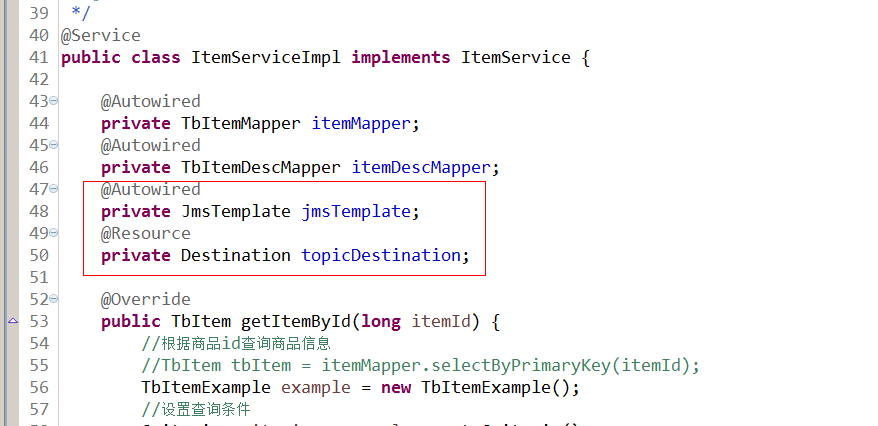
@Override
public TaotaoResult addItem(TbItem item, String desc) {
// 1、生成商品id
final long itemId = IDUtils.genItemId();
// 2、补全TbItem对象的属性
item.setId(itemId);
//商品状态,1-正常,2-下架,3-删除
item.setStatus((byte) 1);
Date date = new Date();
item.setCreated(date);
item.setUpdated(date);
// 3、向商品表插入数据
itemMapper.insert(item);
// 4、创建一个TbItemDesc对象
TbItemDesc itemDesc = new TbItemDesc();
// 5、补全TbItemDesc的属性
itemDesc.setItemId(itemId);
itemDesc.setItemDesc(desc);
itemDesc.setCreated(date);
itemDesc.setUpdated(date);
// 6、向商品描述表插入数据
itemDescMapper.insert(itemDesc);
//发送一个商品添加消息
jmsTemplate.send(topicDestination, new MessageCreator() { @Override
public Message createMessage(Session session) throws JMSException {
TextMessage textMessage = session.createTextMessage(itemId + "");
return textMessage;
}
});
// 7、TaotaoResult.ok()
return TaotaoResult.ok();
}
7.2. Consumer
7.2.1. 功能分析
1、接收消息。需要创建MessageListener接口的实现类。
2、取消息,取商品id。
3、根据商品id查询数据库。
4、创建一SolrInputDocument对象。
5、使用SolrServer对象写入索引库。
6、返回成功,返回TaotaoResult。
7.2.2. Dao层
根据商品id查询商品信息。

映射文件:
<select id="getItemById" parameterType="long" resultType="com.taotao.common.pojo.SearchItem">
SELECT
a.id,
a.title,
a.sell_point,
a.price,
a.image,
b. NAME category_name,
c.item_desc
FROM
tb_item a
JOIN tb_item_cat b ON a.cid = b.id
JOIN tb_item_desc c ON a.id = c.item_id
WHERE a.status = 1
AND a.id=#{itemId}
</select>
7.2.3. Service层
参数:商品ID
业务逻辑:
1、根据商品id查询商品信息。
2、创建一SolrInputDocument对象。
3、使用SolrServer对象写入索引库。
4、返回成功,返回TaotaoResult。
返回值:TaotaoResult
public TaotaoResult addDocument(long itemId) throws Exception {
// 1、根据商品id查询商品信息。
SearchItem searchItem = searchItemMapper.getItemById(itemId);
// 2、创建一SolrInputDocument对象。
SolrInputDocument document = new SolrInputDocument();
// 3、使用SolrServer对象写入索引库。
document.addField("id", searchItem.getId());
document.addField("item_title", searchItem.getTitle());
document.addField("item_sell_point", searchItem.getSell_point());
document.addField("item_price", searchItem.getPrice());
document.addField("item_image", searchItem.getImage());
document.addField("item_category_name", searchItem.getCategory_name());
document.addField("item_desc", searchItem.getItem_desc());
// 5、向索引库中添加文档。
solrServer.add(document);
solrServer.commit();
// 4、返回成功,返回TaotaoResult。
return TaotaoResult.ok();
}
7.2.4. Listener
public class ItemChangeListener implements MessageListener {
@Autowired
private SearchItemServiceImpl searchItemServiceImpl;
@Override
public void onMessage(Message message) {
try {
TextMessage textMessage = null;
Long itemId = null;
//取商品id
if (message instanceof TextMessage) {
textMessage = (TextMessage) message;
itemId = Long.parseLong(textMessage.getText());
}
//向索引库添加文档
searchItemServiceImpl.addDocument(itemId);
} catch (Exception e) {
e.printStackTrace();
}
}
}
7.2.5. Spring配置监听
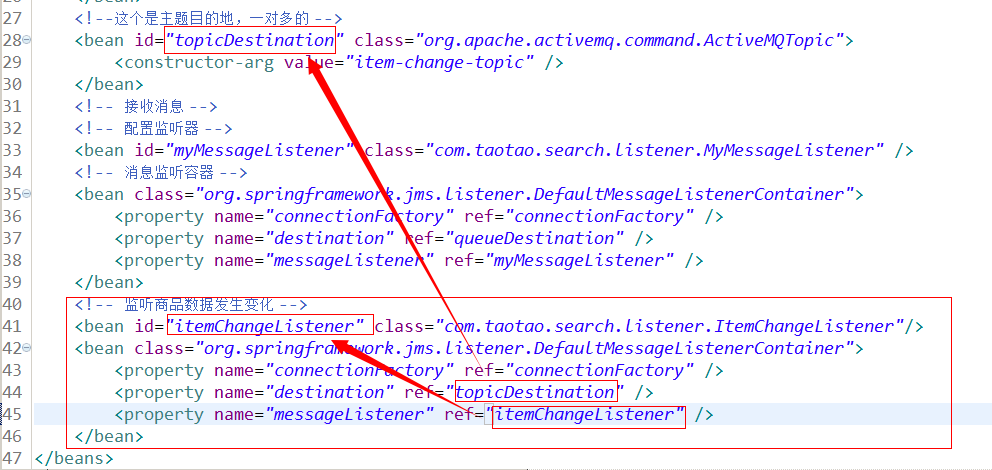
消息队列—ActiveMQ的更多相关文章
- 消息队列ActiveMQ的使用详解
通过上一篇文章 <消息队列深入解析>,我们已经消息队列是什么.使用消息队列的好处以及常见消息队列的简单介绍. 这一篇文章,主要带大家详细了解一下消息队列ActiveMQ的使用. 学习消息队 ...
- Java消息队列--ActiveMq 实战
1.下载安装ActiveMQ ActiveMQ官网下载地址:http://activemq.apache.org/download.html ActiveMQ 提供了Windows 和Linux.Un ...
- lesson5:利用jmeter来压测消息队列(activemq)
本文讲述了利用jmeter来压测消息队列,其中消息队列采用apache的activemq,jmeter本身是支持符合jms标准消息队列的压测,由于jmeter的官方sampler配置比较复杂,本文直接 ...
- 深入浅出 消息队列 ActiveMQ(转)
一. 概述与介绍 ActiveMQ 是Apache出品,最流行的.功能强大的即时通讯和集成模式的开源服务器.ActiveMQ 是一个完全支持JMS1.1和J2EE 1.4规范的 JMS Provide ...
- JMS(Java消息服务)与消息队列ActiveMQ基本使用(一)
最近的项目中用到了mq,之前自己一直在码农一样的照葫芦画瓢.最近几天研究了下,把自己所有看下来的文档和了解总结一下. 一. 认识JMS 1.概述 对于JMS,百度百科,是这样介绍的:JMS即Java消 ...
- Java消息队列--ActiveMq 初体验
1.下载安装ActiveMQ ActiveMQ官网下载地址:http://activemq.apache.org/download.html ActiveMQ 提供了Windows 和Linux.Un ...
- java消息队列--ActiveMQ
1.下载安装ActiveMQ ActiveMQ官网下载地址:http://activemq.apache.org/download.html ActiveMQ 提供了Windows 和Linux.Un ...
- 第十一章 企业项目开发--消息队列activemq
注意:本章代码基于 第十章 企业项目开发--分布式缓存Redis(2) 代码的github地址:https://github.com/zhaojigang/ssmm0 消息队列是分布式系统中实现RPC ...
- 消息队列activeMq 使用介绍
深入浅出 消息队列 ActiveMQhttp://blog.csdn.net/jwdstef/article/details/17380471 一. 概述与介绍 ActiveMQ 是Apache出 ...
随机推荐
- css 2D动画
2D动画: 通过 CSS3 transform转换,我们能够对元素进行移动.缩放.转动.拉长或拉伸. 2D移动:translate().使用translate()函数,你可以把元素从原来的位置移动. ...
- Gridview中实现求和统计功能
GridView加入自动求和求平均值小计 效果图: 解决方案: private double sum = 0; //取指定列的数据和,你要根据具体情况对待可能你要处理的是int protected v ...
- HDU4864 Task
题意 Today the company has m tasks to complete. The ith task need xi minutes to complete. Meanwhile, t ...
- [深度学习]实现一个博弈型的AI,从五子棋开始
好久没有写过博客了,多久,大概8年???最近重新把写作这事儿捡起来……最近在折腾AI,写个AI相关的给团队的小伙伴们看吧. 搞了这么多年的机器学习,从分类到聚类,从朴素贝叶斯到SVM,从神经网络到深度 ...
- Maven中配置生成单元测试报告配置
对junit单元测试的报告: 1. ------------------------------------------------------- 2. T E S T S 3. ------ ...
- RK3288 HDMI增加特殊分辨率
转载请注明出处:https://www.cnblogs.com/lialong1st/p/9174475.html CPU:RK3288 系统:Android 5.1 本帖以 HDMI 800x600 ...
- wdlinux重新编译nginx
背景: 由于web站点需要换主机,并且切换环境. 站点需要做反相代理(nginx),主机从美国迁移到香港[考虑到速度问题,为什么不用大陆阿里云ECS服务器?几十个域名备案麻烦,还有阿里云内地没有多ip ...
- thinkphp3.2.3版本在windows本地apache环境运行正常,上传到centos服务器apache环境中出现:thinkphp 上传根目录不存在!请尝试手动创建:uploads/
thinkphp 上传根目录不存在!请尝试手动创建:uploads/ ,是根目录下uploads权限问题,我把uploads权限改成了775,就可以上传图片了. chmod -R 775 u ...
- Java-Runoob-高级教程:Java 序列化
ylbtech-Java-Runoob-高级教程:Java 序列化 1.返回顶部 1. Java 序列化 Java 提供了一种对象序列化的机制,该机制中,一个对象可以被表示为一个字节序列,该字节序列包 ...
- 1094 The Largest Generation
题意:略. 思路:层序遍历:在结点中增加一个数据域表示结点所在的层次. 代码: #include <cstdio> #include <queue> #include < ...
